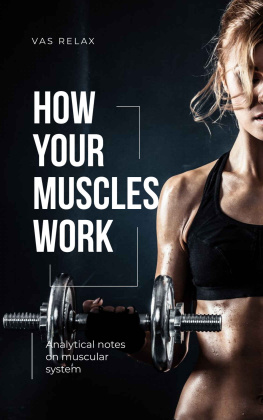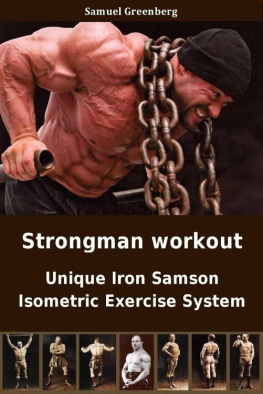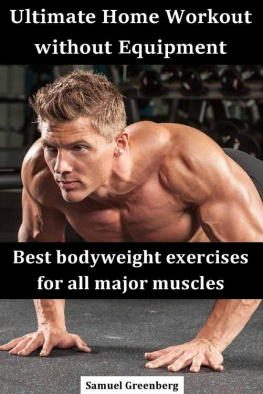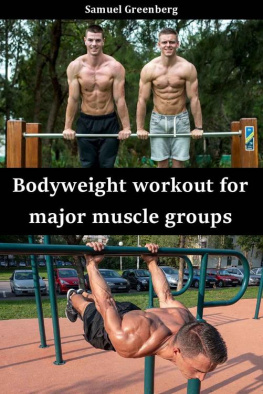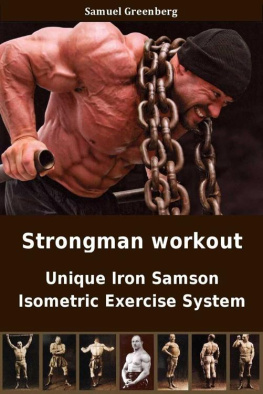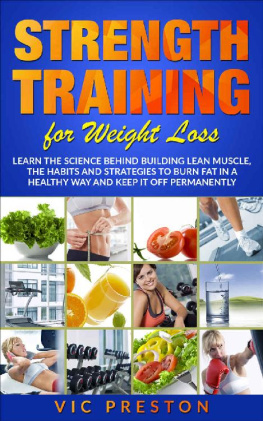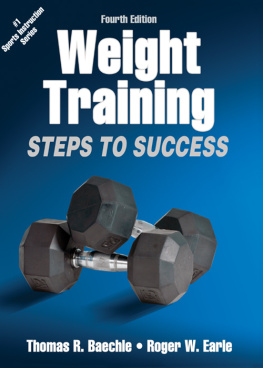CONTENT
Foreword
Chapter - BODY AS WEIGHTENING
Chapter - Hands
Chapter - NECK AND SHOULDER BEL T
Chapter - Chest
Chapter - Middle body
Chapter 6 - Back
Chapter - Hips
Chapter 8 - Buttocks
Chapter 9 - Shins
Chapter 1 - COMPREHENSIVE TRAINING MUSCLES OF THE WHOLE BODY
...
FOREWORD
The following categories of people will love this book:
! Those, who is just getting started and needs to master the basics. Everyone knows what push-ups and squats are, but not everyone is familiar with exercises such as a high shoulder bridge, isometric stretching of the muscles in the support lying on the forearms, or pull-ups in a horizontal position, which are basic for the development of strength.
! Those who want to be in good physical shape, but do not like
visit the gym. If this description applies to you, then you can be sure that you can carry out a complete workout, wherever you are.
! Those who travel a lot. Even if you spent
several hundred or thousands of dollars for sports equipment, but having to leave the house often, it will not do you much good.
! All strength training enthusiasts. Training methods, where in
own weight is used as a burden, it is worth mastering
everyone:
and fans of a healthy lifestyle, and athletes, and
bodybuilders
and trainers, and masseurs, and representatives of other professions,
requiring a certain level of physical fitness. Strength training using this technique will help you build muscle, develop strength, lose weight and correct posture.
The first chapter will introduce you to the principles of training, where the load is created by the body weight. Chapters 2 through 9 focus on functional anatomy and its role in sport and general fitness. Each of them features exercises for the muscles of the arms, neck, shoulders, chest, abdomen, back, hips, buttocks and lower legs. The tenth chapter describes complex exercises for the development of muscles of the whole body and their purpose. In the final, eleventh chapter (perhaps the most
important of all) I'll introduce you to the basics of workout design and give you some sample examples. The book contains about 150 exercises with illustrations and instructions for performing. As you build up strength, you can move from easy options to more difficult ones. To make it easier for you to navigate, I mark them with symbols that reflect the level of difficulty:

First level(1/4) Average level(1/2) Elevated level(1/3) High level(1/4)
A special feature of the book is detailed illustrations that allow you to identify the various muscles and muscle groups that are being worked out during the exercise. Studies show that with the help of physical activity, even individual parts of certain muscles can be purposefully developed, but for this it is very important to know where they are located and how they work. The main and additional muscles are highlighted in the anatomical illustrations in the corresponding color:


Major muscles Additional muscles
After reading the book, you will be well versed in individual muscle groups and master a variety of exercises to develop them. You will learn to follow the exercise technique, which is absolutely essential for physical improvement. You will understand where to start preparing and in which direction to move. You will understand the stabilizing role of the muscles of the midsection and buttocks in almost every movement, learn how to create effective training programs taking into account your personal characteristics and preferences. Finally, you will be able to appreciate strength exercises, which use your own body weight as weights.
Chapter 1
BODY AS WEIGHTENING
A BOUT There are many books written about strength training using your own body weight as resistance. These are mainly collections of common exercises. However, a wide variety of exercises is only part of the story. How you achieve results depends on many factors. It is very important that you not only perform the options that work best for you, but also strike a reasonable balance.
Having devoted a total of 20 years to strength training, I have been interacting intensely with coaches, biomechanics, physiotherapists and researchers over the past decade. With a lot of experience, I can tell at a glance at a training program how effective it is and what results it can bring.
I trust sports coaches the most when designing my training programs. After all, they are interested not only in the strength, endurance and physical form of an athlete. They take care of his health and longevity. Therefore, the main task of the trainer is to develop a high-quality program that allows not only making progress in physical development, but also avoiding negative side effects.
PUSHING AND PULLING MOVEMENTS
It is very important to understand that when using your own body as a weight, pushing movements prevail. The reason is the force of gravity, thanks to which for training we only need to lower the body to the ground, and then push off from it. Think of the squats, lunges, and push-ups. These are great exercises that should definitely be included in the training process. But what about oppositely directed traction movements? You can't grab the floor and pull it towards you!
You will need a chin-up bar or harness to perform these movements, and if you don't have any sports equipment at hand, then solid and stable pieces of furniture. With their help, it is possible to perform traction movements that create the necessary structural balance in the body and prevent unilateral muscle development, leading to disruption of the functioning of the musculoskeletal system.
Nearly every home weight training program Ive encountered tends to focus on pushing. Although they are highly effective, it is necessary to include a sufficient number of deadlifts in the program, paying particular attention to their sequence, as well as the number of approaches and reps. Otherwise, structural imbalances can occur, such as dominance of the quadriceps femoris and associated knee pains, stoop and consequent shoulder pain, or forward tilting of the pelvis and resulting lower back pain. These are just some of the negative consequences of a poorly designed training program.
I started writing this book for two reasons. First, quality and carefully balanced weight-based exercise training programs are in high demand among those who care about their physical condition. Secondly, I myself am an ardent supporter of such exercises. I am convinced that no other training system of its kind focuses as much on the muscles of the back of the body as mine. As already mentioned, if you use your own body weight as a burden, the muscles of its front half are worked out without difficulty, because they perform mainly pushing movements. But any athlete, and just a person who keeps himself in shape, it is clear that it is necessary to pay attention to the muscles of the back half of the body, but without the use of special equipment, this is difficult. Therefore, a creative approach is needed here.
THE BENEFITS OF USING YOUR OWN WEIGHT AS WEIGHT
Some are attracted by the prospect of exercising with all the comforts at home, while others purchase subscriptions to visit fitness centers and are completely dependent on the availability of exercise machines and other equipment. Although I have nothing against other types of weights, the body weight of a person, without any doubt, seems to be the most convenient in this regard. In this case, you do not need anything to practice except your own body. You won't need to cancel your workout due to lack of sports equipment, facilities or instructor. In other words, if you learn to use your body instead of barbells and dumbbells, you will have the opportunity to do a full workout anytime, anywhere. You will be able to do great things in terms of developing strength, endurance and balance. Recent research shows

